blogs about Chinese archaeology, Chinese Hanfu culture and Chinese history etc
Don't wanna be here? Send us removal request.
Note
Your blog is so interesting! Thanks for sharing all this with us. This might not be your area of expertise, but I've been watching love game in eastern fantasy and am OBSESSED with Esther Yu's hair in it. Do you know if these styles are based on or inspired by any real historical hairstyles? Or are they just xianxia creativity haha?
Hi!! :D
Thank you for sending in your question! I took a look at the hairstyles for this show and did a quick compilation:

So it looks most of the hairstyles she has is centre-parted with some small loops on each side, decorated with small flowers and some strands/braids trailing down.
When I searched for a dynasty this show was set in, officially it's "jiakong" (not based in an actual time period) but some fans have spotted hints of Tang/Song.
This sort of hairstyle would likely be a mish-mash of several different styles put together:

Centre-parted hair with some sort of bun or small loops on either side is a style that was common in several dynasties, but used for very young girls or servants. So the character designer(s) definitely took inspiration from history, but added their own touch to it :)
188 notes
·
View notes
Text
[China History] Bound by Blood, Denied by Law: A History of Women’s Inheritance in China[Eng Sub]
Step into a thousand years of silence.
This is a film about women’s inheritance rights were gradually stripped away during the era of China’s feudal dynasties.
This is not just history. This is herstory.
A narrative long buried under rituals, surnames, and silence — now unearthed.
work by Bao Xian (@宝苋xian)
————————
🧚🏻Production & Actor:@宝苋xian
🔗Douyin:https://v.douyin.com/UtQyMA3ZAyI/ 01/15 Ate:/ S@Y.MJ
————————
#chinese hanfu#herstory#women’s inheritance rights#hanfu#hanfu accessories#hanfu_challenge#china#chinese traditional clothing#china history#woman right#chinese#宝苋xian#imperial china#历史#女性历史#漢服#汉服#中華風
207 notes
·
View notes
Text


The Mogao Caves at Dunhuang is very famous in China, especially for those who are interested in history. I haven't had a chance to visit yet, but it's on my to-do list :D




419 notes
·
View notes
Text
A fairly good general reference video about historical/traditional fashion of various cultures and peoples (including hanfu, but not just hanfu) that have been part of Chinese history:
youtube
The video is arranged in chronological order, below are the timestamps:
0:24 - Warring States period/战国 hanfu (for those who don't know: hanfu/汉服 is the historical and traditional outfits of Han people/汉族)
1:16 - Western Han dynasty/西汉 hanfu
2:11 - Jingjue Kingdom/精绝 and Loulan Kingdom/楼兰 historical outfits
2:45 - Eastern Han dynasty/东汉 to Three Kingdoms period/三国 hanfu
3:51 - Northern Dynasties/北朝 Xianbei/鲜卑 historical outfits
4:46 - Southern Dynasties/南朝 hanfu
5:25 - Sui dynasty/隋 hanfu
5:56 - Tang dynasty/唐 hanfu
6:38 - Sogdian/粟特 historical outfits
6:59 - Tubo Empire/吐蕃 Tibetan/藏族 historical outfits
7:38 - Huihu/回鹘 historical outfits (Qocho Huihu Kingdom/高昌回鹘 and Ganzhou Huihu Kingdom/甘州回鹘; note: Huihu people are the ancestors of the modern Uyghur people/维吾尔族)
8:21 - Nanzhao Kingdom/南诏 historical outfits (of the ancestors of the modern Yi people/彝族 and Bai people/白族)
9:07 - Five Dynasties/五代 hanfu
9:57 - Northern Song dynasty/北宋 hanfu
10:38 - Liao dynasty/辽 Khitan/契丹 historical outfits
11:21 - Jin dynasty/金 Jurchen/女真 historical outfits
12:07 - Western Xia/西夏 Tangut/党项 historical outfits
12:37 - Dali Kingdom/大理 historical outfits (of the ancestors of the modern Bai people/白族)
13:20 - Southern Song dynasty/南宋 hanfu
14:00 - Yuan dynasty/元 Mongolian/蒙古族 historical outfits
14:58 - Yuan dynasty women's hanfu
15:24 - Ming dynasty/明 hanfu
16:24 - Qing dynasty/清 Manchu/满族 traditional outfits
16:59 - Qing dynasty Han women's outfit
**Note: as mentioned by the OP, due to the lack of suriviving physical artifacts for some time periods/cultures/kingdoms/dynasties, there is a certain amount of speculation in this video based on other artifacts/records like wall murals, paintings, figurines, and historical records.
595 notes
·
View notes
Text
[Hanfu · 漢服]Chinese Tang Dynasty(618–907AD)Traditional Crown & Hanfu In Cdrama 【国色芳华/Flourished Peony】
♦ 𝗖𝗵𝗶𝗻𝗲𝘀𝗲 𝗔𝗰𝘁𝗼𝗿: 𝗭𝗵𝗮𝗻𝗴 𝗬𝗮𝗾𝗶𝗻/张雅钦 as Li Youzhen (李幼贞) “县主/County Princess/Lord”




【Historical Artifacts Reference 】:
▶The crown and hair ornaments unearthed from the tomb of Li Chui,/李倕, a fifth-generation granddaughter of Emperor Gaozu of Tang China




2.Gold necklace inlaid with pearls and gemstones, Late Sui Dynasty
Excavated in 1957 from the tomb of Li Jingxun, Xi'an, Shaanxi,China.

"Flourished Peony" (《国色芳华》) is a really cool Chinese drama that dives deep into the Tang Dynasty. It takes a close look at the fashion, makeup, and etiquette of that time. The show’s team did a ton of research, to restore Tang Dynasty artifacts to get the hanfu and makeup just right. You can really see the effort they put into making everything look authentic and true to the era.
If you're into Tang Dynasty Hanfu,Makeup , or the whole vibe of that period, I highly recommend watching this drama. It's a great way to get a glimpse of ancient Chinese culture through a really well-done romantic drama. ---------------
【Debate on the Interpretation and Wearing of the Li Chui Tomb Crown Ornaments】
The crown ornaments unearthed from the tomb of Li Chui (李倕) are still a topic of debate due to the fact that the pieces were found scattered, making the exact method of wearing unclear. The version currently displayed in the museum is a reconstruction based on the collaborative efforts of Chinese and German experts. However, some scholars in China have a different view, arguing that this ornament may not necessarily be a "crown."
Fwe can refer to the perspective of the author(@左丘萌) of Chinese Beauty and Adornments: The Tang Dynasty Daughters (《中国妆束:大唐女儿行》), who offers an alternative interpretation of how this crown ornament was likely worn(If anyone are interested, you can save the picture and translate it through the translator)
the right is the author (@左丘萌)'s restoration result and analysis process of the relics:





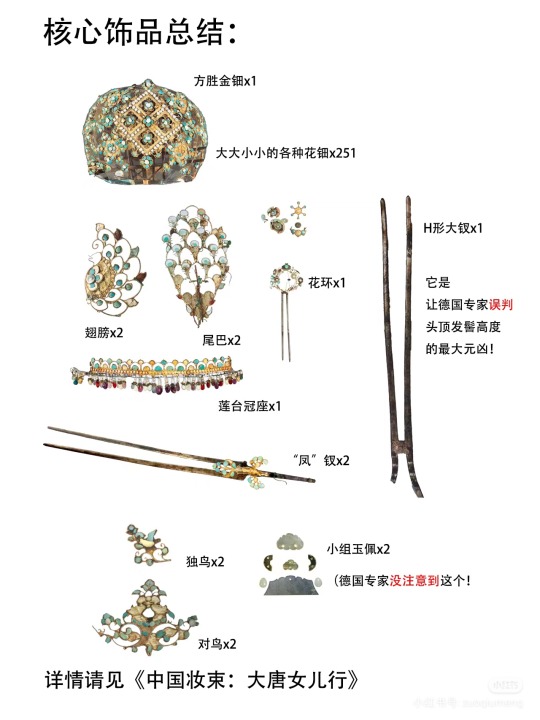




————————
📸Photo:Chinese Drama 【国色芳华/Flourished Peony】
🔗Crown analysis image source: http://xhslink.com/a/aJdFM1q0QIe8
————————
#chinese hanfu#Tang Dynasty(618–907AD)#crown ornaments#Li Chui#李倕#chinese drama#国色芳华/Flourished Peony#hanfu#hanfu accessories#hanfu_challenge#china#chinese traditional clothing#chinese
145 notes
·
View notes
Text


And we're back in business!! Chugging along into the Golden era of the Tang Dynasty :D
Four Tang (四唐) The Tang Dynasty is often referred to as the Golden Age of Chinese history. With a flourishing economy and rich cultural developments, the Tang Dynasty went through some significant changes through its 290 years.
The "Four Tang" was originally used to differentiate different styles of poetry during the Tang Dynasty, but have also become used to categorize Hanfu styles. Please note that there is some discrepancy when exactly each period started/ended, but these are the general years used: Early Tang / 初唐(618 — 713 AD) Golden Era / 盛唐(713 — [755~766] AD) Mid Tang / 中唐([755~766] — [825~836] AD) Late Tang / 晚唐([825~836] — 907 AD)
Putting this image here because this lady looks just like me xDD I love it <3





232 notes
·
View notes
Text




(Not done with the Qin/Han robes yet, but taking a quick break to hop to the next time period for something a bit different.)
魏晋南北朝的襦裙 Ruqun (2-piece outfit) during the Wei-Jin + Northern/Southern Dynasties (220 - 589 AD)
This time period spans over 350 years and incorporates: 1) the Three Kingdoms era, 2) the Jin Dynasty, 3) the Northern/Southern dynasties
History background: Towards the end of the Eastern Han dynasty, the Han empire split into three kingdoms (Wei, Han, Wu) with Wei being the most powerful. Following almost a century of fighting, the three kingdoms were unified under the Jin Dynasty. Unfortunately, this didn't bring peace to the country as power struggles continued. Due to the continuous fighting, China's population was reduced drastically and many tribes from the north attacked, hoping to enlarge their own territory. This was a period of non-stop fighting and conflict, and it wasn't until the Sui Dynasty(581- 618 AD) that the country once again found peace.
Hanfu during this period: In terms of Hanfu, many new styles appeared influenced by a clash of different ethnic groups and cultures. In the Eastern Han/Three Kingdoms period, Hanfu started to evolve from a 1-piece long robe (known as "Shenyi"/深衣) to a 2-piece set with the top and bottom separated (known as "Ruqun"/襦裙). The bottom skirt is pieced together using several long, rectangular pieces, pleated at the top and attached to a waist belt, allowing the bottom to flare out.
This 2-piece Ruqun style reached a peak during the Wei-Jin Northern/Southern dynasties period, and laid the foundation for many Hanfu styles in later dynasties.
*NOTE: Since there are so many different styles during this period, there's a lot of information to dig through. I'm going to do my best to keep the it simple and straightforward, but if I get anything wrong or if there's anything confusion feel free to let me know :D
123 notes
·
View notes
Text


One of the first Hanfu outfits I bought was this style (I still have it). At the time I thought it was representative of the Tang Dynasty, but later found out that it's more likely a style from the Five Dynasties (right after the Tang Dynasty). Some historians have also speculated that the one large flower on the top of the head is more of a Song Dynasty style rather than Tang.
It's a good reminder that all of these speculations about historical styles are based on what we can actually dig up, but obviously tombs are limited. Maybe tomorrow we'll find a new tomb with new artefacts that'll throw everything we think today upside-down xD




366 notes
·
View notes
Text
[Hanfu · 漢服]Chinese Tang Dynasty(618–907AD)Traditional Clothing Hanfu Based On Female Dancer figurines of Tang Dynasty











【Historical Artifacts Reference 】:
▶Set of China Tang Dynasty“Tang Sancai" Figurines of Musicians and Dancers<鳥歌萬歲樂>・Wuzetian Period
Shaanxi Tang Sancai Art Museum Collection




In the Tang Dynasty, women who usually wore bird crowns were mostly dancers, and the bird was often in the shape of a peacock or a parrot.
The historical records mention the bird crown worn by women during the Tang Dynasty several times. For instance, in Du You's Tongdian (Volume 6, "Music Section," regarding the "Sitting and Standing Performers"/《通典》乐六“坐立部伎), it is recorded: "The Guangsheng music(光圣乐) was created by Emperor Xuanzong. The dancers, eighty in number, wore bird crowns and multicolored painted robes. They were dressed in the style of the Upper Yuan and Shenshou festivals, to sing of the emperor's achievements." Similar records are found in Xin Tang Shu /《新唐书》(Volume 22) and Taiping Yulan by Song Li Fang: "When Emperor Zhongzong ascended the throne, he created the Longchi music/龙池乐, with twelve dancers, wearing lotus crowns and stepping on special shoes, performing with elegant music, though without bells. He also created the 'Shenshou music/《圣寿乐》,' in which the female dancers wore five-colored embroidered robes and performed.
Additionally, he created the 'Xiao Po Zhen music/《小破阵乐》,' with dancers dressed in armor. Lastly, the 'Guangsheng music/《光圣乐》' had dancers wearing bird crowns and painted robes, to sing of the emperor's accomplishments."
Taiping Yulan (Volume 568, Music Section 6) records: "Empress Wu had the 'Bird Song for Ten Thousand Years' music composed during a grand banquet in the Eastern Xiangluan Hall of the palace. At that time, birds capable of speaking were kept in the palace, and they often repeated 'Ten Thousand Years.' This music was created to symbolize this. There were three dancers, with large red sleeves, adorned with painted birds resembling the 'quail-like bird' (quyu). In present-day Lingnan, there are birds similar to the quail that, when raised for a long time, can speak, and they are called 'Jilie'/《鸡烈》."

Tang Dynasty Sancai female seated figurine from the Palace Museum
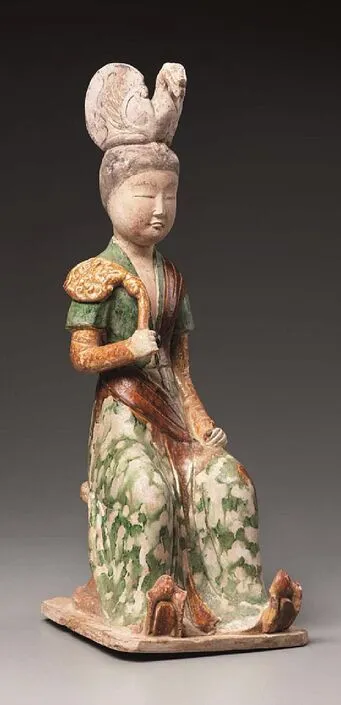
The Boston Museum of Fine Arts houses a Tang Dynasty Sancai female seated figurine
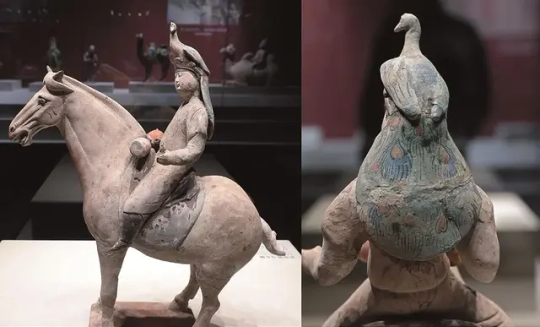
Tang Dynasty Female figurine of a horse-riding musician unearthed from the tomb of the county lord of Jinxiang
————————
📸Photo:@摄影师 韩超(拍摄 器材)
💄Makeup∶@古卷
🔗Weibo:http://xhslink.com/a/Bs9rgdSfq8a7
————————
#chinese hanfu#Tang Dynasty(618–907AD)#hanfu#hanfu accessories#hanfu_challenge#chinese traditional clothing#china#chinese#Bird crown#Dancer#Chinese Aesthetics#漢服#汉服#中華風#古卷
199 notes
·
View notes
Text
chinese craftsmanship 螺钿luodian/mother-of-pearl inlay




chinese mamianqun fashion inspired by 螺钿luodian




1K notes
·
View notes
Text
[Hanfu · 漢服]China Ming Dynasty (1368–1644) Chinese Traditional Clothing Hanfu & Mamian qun/Horse face skirt
Which one is your favorite 💖?

















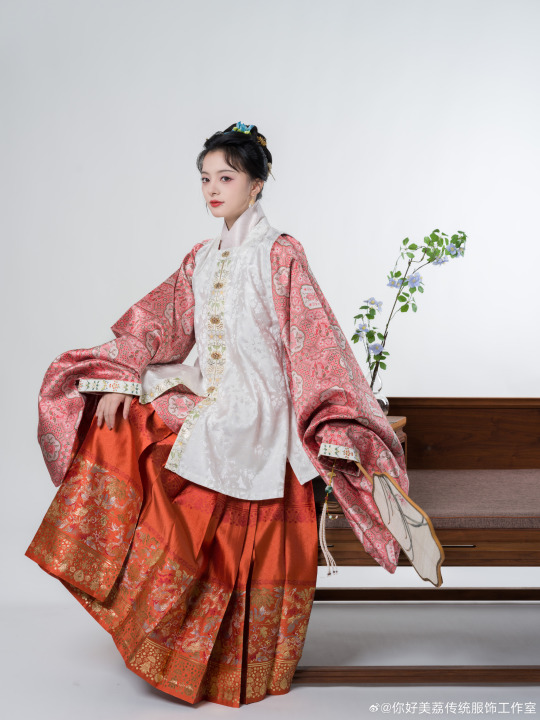


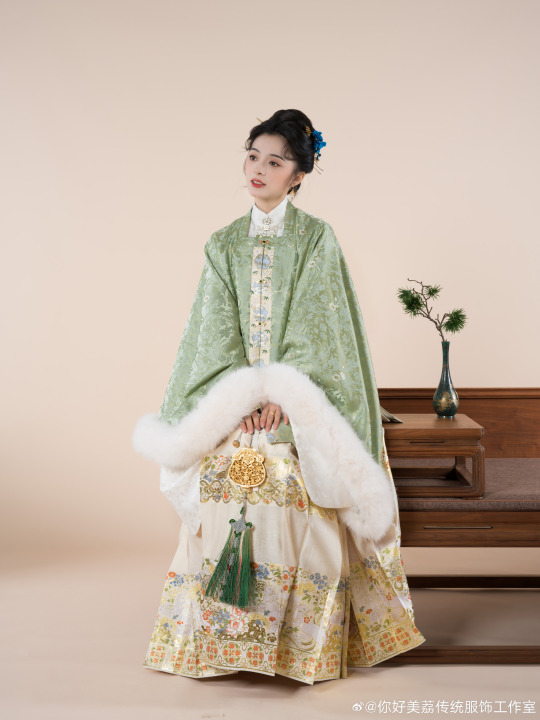









______
📸Photo:@你好美荔传统服饰工作室
👗Hanfu: @你好美荔传统服饰工作室
🧚🏻 Model :@阿时Ashi_
🔗Weibo:https://weibo.com/u/5698195062
_______
#chinese hanfu#Ming Dynasty (1368–1644)#hanfu#hanfu accessories#hanfu_challenge#china#chinese traditional clothing#chinese#漢服#汉服#中華風#hanfu girl#mamianqun#你好美荔传统服饰工作室#chinese style#chinese fashion#history#chinese art#chinese history#ancient china#Hanfu posture reference
151 notes
·
View notes
Text
[Hanfu · 漢服]Chinese Tang Dynasty (618–907AD) Traditional Clothing Hanfu Based On Tang Dynasty Dunhuang Mural















【Historical Reference Artifacts】:
China Tang Dynasty Dunhuang Mural《Donor in Cave 9 of Dunhuang Mogao Grottoes/莫高窟第9窟供养人像 》


————————
📸Photo:@佳期阁
🧚🏻Model :Owner of 佳期阁
👗Hanfu: @佳期阁
🔗Weibo:https://weibo.com/6614078088/OFh3sakl9?pagetype=profilefeed
————————
#chinese hanfu#Tang Dynasty#hanfu#hanfu accessories#hanfu_challenge#chinese traditional clothing#china#chinese#Donor in Cave 9 of Dunhuang Mogao Grottoes/莫高窟第9窟供养人像#佳期阁#漢服#汉服#中華風#chinese historical fashion#chinese historical hairstyle
274 notes
·
View notes
Text

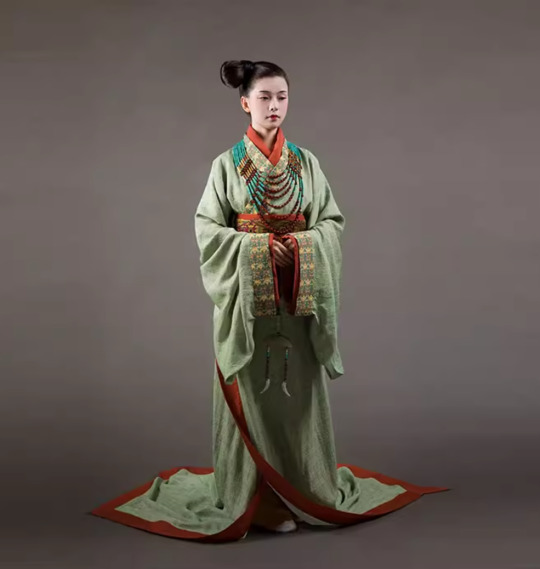
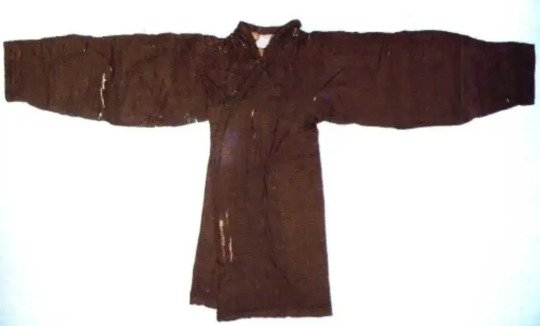

直裾战国袍 / Straight-edged Warring States robe: Distinguished by the excessive amount of fabric for the sleeves and the waist-to-floor straight edge, this style of Warring States robe was worn between the Warring States period and the Han Dynasty.
Warring States robes can usually be purchased in 2 lengths; - trailing on the floor (great for photos, awful for walking) - hemmed right at the floor (not as beautiful in photos, a lot easier for walking) Most stores selling this style of robes have skipped the extra piece of fabric between the sleeve and body, changing the entire drape of the fabric. Instead of it naturally opening at the front, this small change in the design causes the fabric to be completely closed at the front which makes walking without stepping on the fabric impossible (speaking from personal experience) T___T
==**==**==**==**==**==**==**==
Hanfu, the historical clothing of the Han people in China, has thousands of years of history. Since the 2000s, there has been a revival of Hanfu within China, with many Hanfu stores opening in the past two decades.
I first became aware that I could purchase Hanfu in 2021 and hoarded a bunch. Recently, I started digging more and more into the topic and realized that, while many of the Hanfu being sold are beautiful, they're not exactly true to the styles of Hanfu in the past. That's not to say they shouldn't be sold or worn, I'm not interested in gatekeeping what others wear, but I became intrigued by what exactly DID the historical Hanfu styles look like based on historical artefacts.
For my own interest, and for any others who might be interested, I'm going to try and do a series of the various Hanfu styles throughout the dynasties.
Chinese dynasties timeline for reference:
Shang Dynasty 商 (1300–1046 BC) Zhou Dynasty 周 (1046–256 BC) Western Zhou 西周 (1046–771 BC) Eastern Zhou 东周 >> Spring and Autumn Period 春秋 (770–481 BC) >> Warring States Period 战国 (481–221 BC) Qin Dynasty 秦 (221–207 BC) Han Dynasty 汉 >> Western Han 西汉 (206 BC–8 AD) >> Xin Dynasty 新 (9–23) >> Eastern Han 东汉 (25–220) Three Kingdoms 三国 (220–265) Jin Dynasty 晋 >> Western Jin 西晋 (265–316) >> Eastern Jin 东晋 (317–420) Northern and Southern Dynasties 南北朝 (420–589) Sui Dynasty 隋 (581–618) Tang Dynasty 唐 (618–907) Five Dynasties 五代 (907–960) Song Dynasty 宋 >> Northern Song 北宋 (960–1127) >> Southern Song 南宋 (1127–1279) Yuan Dynasty (Mongols) 元 (1271–1368) Ming Dynasty 明 (1368–1644) Qing Dynasty (Manchus) 清 (1644–1911) Republic of China 民国 (1912–1949) People's Republic of China 中华人民共和国 (1949-present)
418 notes
·
View notes
Text
🐍🧧WISH EVERYONE HAVE A HAPPY NEW YEAR🧧🥳

2025 is the Year of the Yi Si Snake (乙巳蛇年).
This year is also my first time trying to draw a snake after I drew a dragon for the last year. I found out that the snake's expression is more difficult to draw 😵💫
I drew it with the concept of "the snake embroidery on the clothes reveals its true form",hope u guys like it☺️❤️
【Historical Artifacts Reference】
Water-color miscellaneous treasures, four-in-one, Ruyi, cloud pattern and Luogua “Dahu”,During the Wanli period/万历时期水色杂宝四合如意云纹罗


【What is Dahu/褡护】
Dahu (simplified Chinese: 褡護; traditional Chinese: 褡護; pinyin: Dāhù) was a form of robe/jacket which originated in the Ming dynasty.In Ming dynasty, the dahu was either a new type of banbi (Chinese: 半臂; lit. 'half-arm') or a sleeveless jacket, whose designs was influenced by the Mongol Yuan dynasty clothing.
In the Ming dynasty, the dahu could be worn over the tieli robe and/or could be worn under the round-collar robe.Some forms of dahu was bestowed to the Joseon Kings; for example, in 1444 under the rule of King Sejong of Joseon, the Ming dynasty bestowed him dahu, along with cheollik and gollyeongpo.
China Ming Dynasty ancestor portraits showing wearing Dahu

#chinese hanfu#chinese new year#hanfu#hanfu accessories#hanfu_challenge#china#chinese traditional clothing#chinese#year of the snake#乙巳蛇年#Dahu/褡护#Happy New Year#中華風#汉服#漢服#art by me
77 notes
·
View notes
Text
Lion dance

The lion dance, is a form of traditional dance performed on joyous festivals and big occasions, such as the Spring Festival (Chinese New Year). It is a dance which imitates a lion’s various movements and actions, performed in a lion costume, accompanied by the music of beating drums and gong instruments.
It is believed that the lion is an auspicious animal that brings good luck.Therefore, a lion dance is performed to pray for good luck during the Spring Festival or during other celebrations.
The lion dance is an excellent Chinese folk art that has spread across the world, courtesy of local Chinese communities and immigrant groups who have settled in different countries, particularly in Malaysia and Singapore. Also, the overseas Chinese people in European countries and America have established many lion dance clubs, performing on Chinese festivals or on big occasions.
Origin
Opinions about the origin of the lion dance are widely divided. The most reliable one is this:
In traditional Chinese culture, the lion, like the dragon and the Chinese unicorn (麒麟), was only an animal which existed in myth, and there were no actual lions in China. Before the Han Dynasty (202 BC – 220 AD), only a few lions had reached the Central Plains from the western area of ancient China (now Xinjiang).
At that time, people mimicked the appearance and actions of the newly arrived lions in a performance, which developed into the lion dance in the Three Kingdoms Period (220–280) and then became popular with the rise of Buddhism in the Northern and Southern Dynasties (420–589). In the Tang Dynasty (618–907), the lion dance was one of the court dances.
Styles
The Lion dance was divided into two styles,
The Northern Lion dance:
The northern lion dance has close relations to wushu (martial arts). Usually, a young lion is performed by a single person and an adult lion is performed by a duo.

The southern Lion dance:
The southern lion dance originated from Guangdong, and it is famous in Hong Kong, Macau, and the hometowns of overseas Chinese people. The southern lion dance is also performed in pairs, and the performers wear a lion costume. The southern lion dance is a performance based on the study of a lion’s behavior.

Source: http://www.chinahighlights.com/
206 notes
·
View notes
Text
[China] Tries to restore the famous dance during the China Tang and Song Dynasties< Zhezhi Dance/柘枝舞>
The blogger tried to restore the dance by referring to the movements in many related reliefs and murals from the Tang Dynasty to the Five Dynasties, combined with the Tang Dynasty records of the dance.
< Zhezhi Dance/柘枝舞>
is a type of well-known "Jian dance/健舞"from the Tang and Song dynasties. The ancient "Yudiao" (羽调) has a piece titled "Zhezhi Qu" (柘枝曲), and the Shang Diao (商调) has "Qu Zhezhi" (屈柘枝), from which the dance takes its name. It originated from Talas (a region in modern-day Kazakhstan, once under the jurisdiction of the Tang Dynasty's Anxi Protectorate). Initially, it was a solo dance performed by women. The most popular form during the Tang Dynasty was the "Double Zhezhi Dance/《双柘枝舞》," performed by two young girls wearing red and purple silk robes, with Hu-style(胡人/Foreigner style) hats adorned with golden bells. They would dance in time with the beat of the Hu drums, their slender waists swaying in harmony with the ringing of the bells and the dance movements, creating a pleasant sound as they turned.
Zhang Xiaobiao/章孝标's poem 《Zhezhi /柘枝》includes the line "Zhezhi first appears, the drumbeat calls," and Bai Juyi/白居易's poem 《Zhezhi Ji/柘枝妓》 has the line "Three drumbeats strike, urging the painting drum." The dance features rich variations in movement, being both vigorous and lively, as well as graceful and charming. The sleeves of the dancer's costume alternately droop and lift, as described in the poem with phrases like "lifting sleeves amidst the busy drum" and "long sleeves sweeping into the embroidered train." The rapid and intricate footwork causes the golden bells worn by the dancer to produce a clear, crisp sound. Spectators are amazed by the dance's lightness and flexibility. As the dance nears its end, there is a deep bending motion of the waist.
-------- Annotation >Yudiao(羽调) & Shang Diao (商调)<
The Chinese pentatonic scale, or pentatonic mode, is a scale system commonly used in Chinese music. Ancient China named these five notes Gong, Shang, Jiao, Zheng, and Yu(宫、商、角jué、徵zhǐ、羽) in sequence, which is roughly equivalent to the singing notes in Western music notation. Noun (do), (re), (mi), (sol), (la).
--------
In the Song Dynasty, it evolved into a group dance, and the official music included "Zhezhi Troupe" (柘枝队). There were many variations of the dance in the past, though most of the original songs were lost by the Song period. Despite this, the dance still flourished. Since the Yuan Dynasty, the dance itself disappeared, and the name "Zhezhi Ling" (柘枝令) only survives in the lyrics and music.
Along with the Hu Xuan Dance (胡旋舞) and Hu Teng Dance (胡腾舞), Zhezhi Dance was one of the three major Western Region dance styles that were immensely popular during the Tang Dynasty, often performed to welcome foreign envoys gathering in Chang'an China.
【Historical Artifact Reference】:
China Five Dynasties and Ten Kingdoms Period Brick Carving Relics from Tomb Of Feng Hui 冯晖墓

< "Jian dance/健舞 & Ruan Wu/软舞>
Jianwu (健舞) is one of the categories of court music and dance in the Tang Dynasty, specifically referring to a type of martial dance. It signifies a dance style characterized by vigorous, forceful movements and a lively rhythm, in contrast to the "soft dance" (软舞).
The Tang people categorized the various small-scale entertainment dances and musical performances popular in the palace, noble households, and among the general populace based on their stylistic characteristics into "soft dance" and "martial dance" (jianwu). Originally folk dances and Hu music, these were later reorganized and adapted by the court's music and dance troupes, often performed at feasts. The music for these dances typically used elaborate wind instruments and fast string instruments. According to the "Fangfang Ji" (放坊记) and "Yuefu Zalu" (乐府杂录), soft dances included pieces like "A Liao" (阿辽), "Jianqi" (剑器), "Zhezhi" (柘枝), "Hu Xuan" (胡旋), "Hu Teng" (胡腾), "Huang Zhuang" (黄獐), "Da Weizhou" (大渭州), "Fu Lin" (拂菻), "Damo Zhi" (达摩支), and "Ling Da" (棱大).
Ruan Wu(soft dance)/软舞
Ruanwu (软舞) specifically referring to a type of graceful and elegant dance. It signifies a dance style characterized by graceful, delicate, and flowing movements, in contrast to "martial dance" (健舞).
The Tang people categorized the various small-scale entertainment dances and musical performances popular in the palace, noble households, and among the general populace based on their stylistic characteristics into "soft dance" and "martial dance" (jianwu). These dances, originally folk dances, were adapted by the court's music and dance troupes and were often performed at feasts. The movements of soft dance were light, graceful, and elegant, resembling either a startled swan or a flying swallow. According to the "Yuefu Zalu" (乐府杂录), the main soft dances included "Liangzhou" (凉州), "Lüyao" (绿腰), "Suhexiang" (苏合香), "Qu Zhezhi" (屈柘), "Tuan Yuan Xuan" (团圆璇), "Ganzhou" (甘州), "Chui Shou Luo" (垂手罗), "Hui Bo Yue" (回波乐), "Lanling Wang" (兰陵王), "Chun Ying Zhuan" (春莺啭), "Ban She Qu" (半社渠), "Jie Xi" (借席), and "Wu Ye Ti" (乌夜啼).
Next time I will make a post to share to the Tang Dynasty "soft dance/软舞" restored by Choreographer:@李诗荟
------
youtube
"Taiping Yue": Ji《太平乐》· 急 (Great Peace Music: Quick), an instrumental movement in the Dashi mode (Chinese: Dashi diao, 大食调, equivalent to the Mixolydian mode on E), dating back to China's Tang Dynasty, as reconstructed by Bilibili user "männlichkeit," c. January 24, 2020. As the final movement of the suite "Taiping Yue," this piece is known by the title "Hehuan Yan" (合欢盐, Happy Together Song). According to musicologist Steven G. Nelson, this suite probably had its origins as a military dance, perhaps of the pozhen yue (破阵乐, literally "destroying the formations") type, in Tang China, which was transmitted to the Japanese court by the early 8th century, then arranged into a suite in the Japanese court of the mid-9th century.
In the context of the piece's title, the term "yan" (塩), which usually means "salt" in Chinese, refers to a particular type of poetic song popular during the Tang period (a synonym for "qu" 曲, meaning "piece"); "yïr" or "yır" means "song" in Turkic languages.
This reconstruction is based primarily on the version of this piece as found in "Sango Yōroku"『三五要録』, the most important and extensive collection of Tang-era scores for 4-string pipa; this collection was compiled by the Japanese nobleman Fujiwara no Moronaga (藤原師長, 1138-1192) shortly after 1177 (c. 1180), during the late Heian period (794-1185).
In Japan's tradition of Tōgaku (唐楽, court music of Chinese origin), this dance suite movement is called "Taiheiraku": Kyū《太平楽》· 急 (たいへいらく:きゅう), with the movement title being pronounced "Gakka-en"《合歡塩》(がっかえん). Its mode is called Taishiki-chō (大食調) in Japanese.
__________________
🧚🏻♀️Dancer & Choreographer:@李诗荟
👗Hanfu:@君子山岚
Venue Provider:@包意凡
Lighting Design:@大彤寶殿的彤寶
Music :@männlichkeit(BiliBili)/@dbadagna(Youtube)
🔗Full Video on Xiaohongshu App:https://www.xiaohongshu.com/explore/674995190000000008005fc6?
__________________
#chinese hanfu#ancient dance#dance history#Tang Dynasty#Jian dance/健舞#Zhezhi Dance/柘枝舞#李诗荟#china#chinese#Dance#Choreographer#five dynasties and ten kingdoms period#Youtube
456 notes
·
View notes
Text
Men's Hanfu throughout history.
Often we overlook men's Hanfu but they're just as beautiful as the women's.
Src: 摄影师馒猫子 【衣冠上国,礼仪之大,故称夏,服装之美,谓之华!】 https://www.bilibili.com/video/BV1Lu4y1P77e/
(ENG subtitles by me :D)
711 notes
·
View notes